Sewage Pumping Stations
Sewage Pumping Stations
Next-day delivery on all of our products
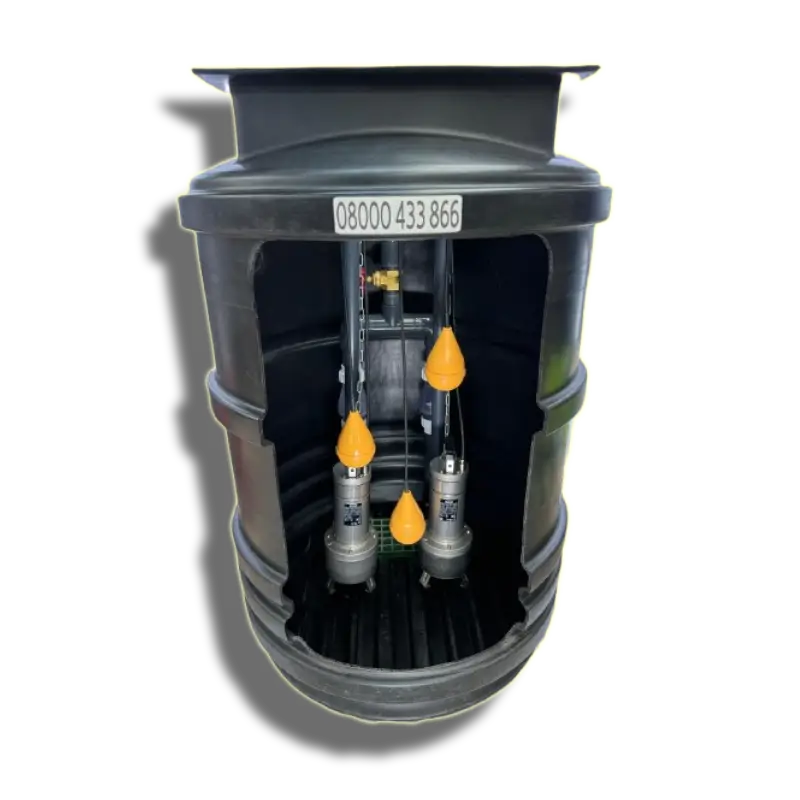
Showing all 23 resultsSorted by price: low to high
-
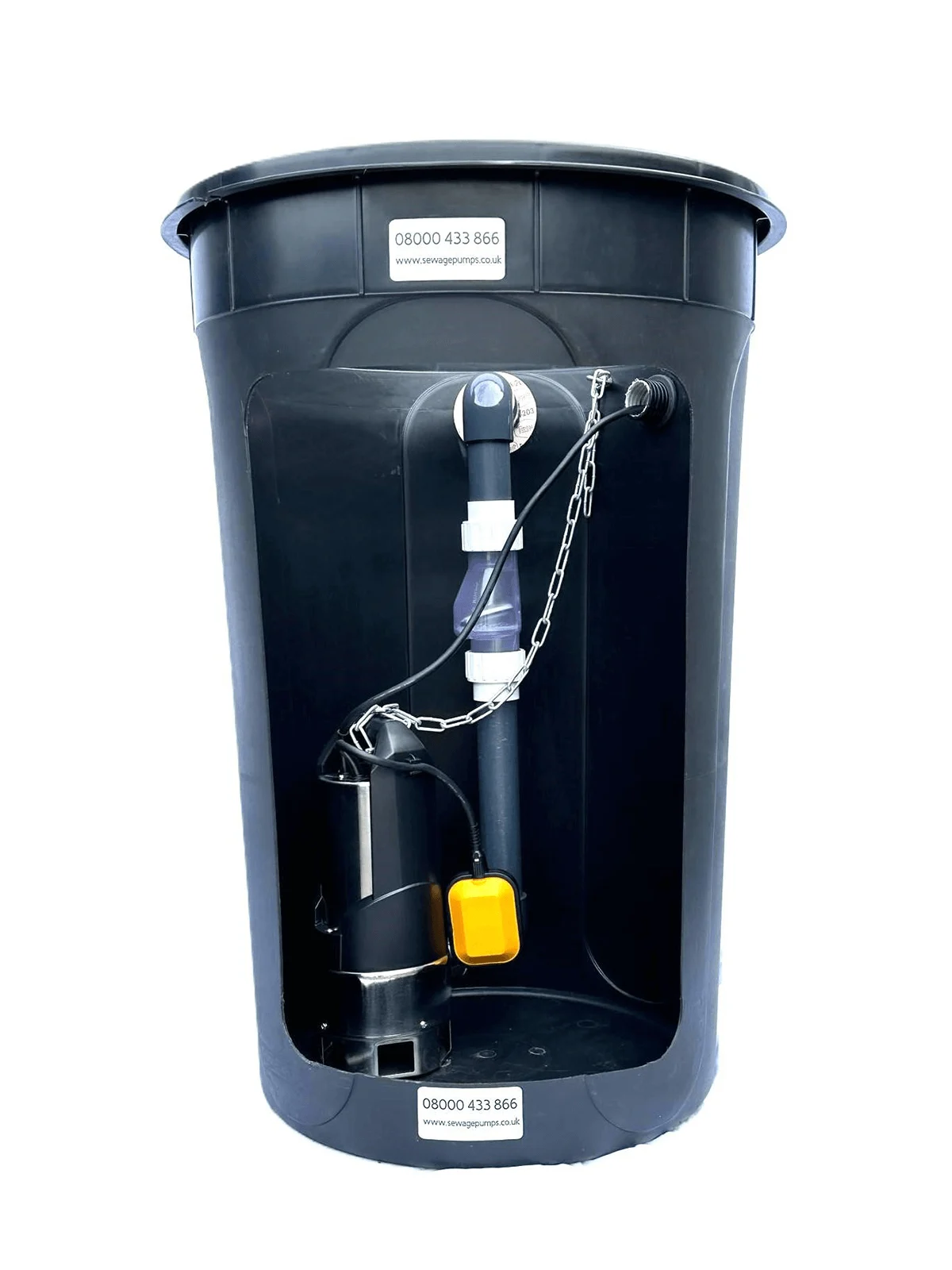
198 Litre Single Pump System (600mm x 0.65m)
£560.00 £672.00 incl. tax Add to basket -
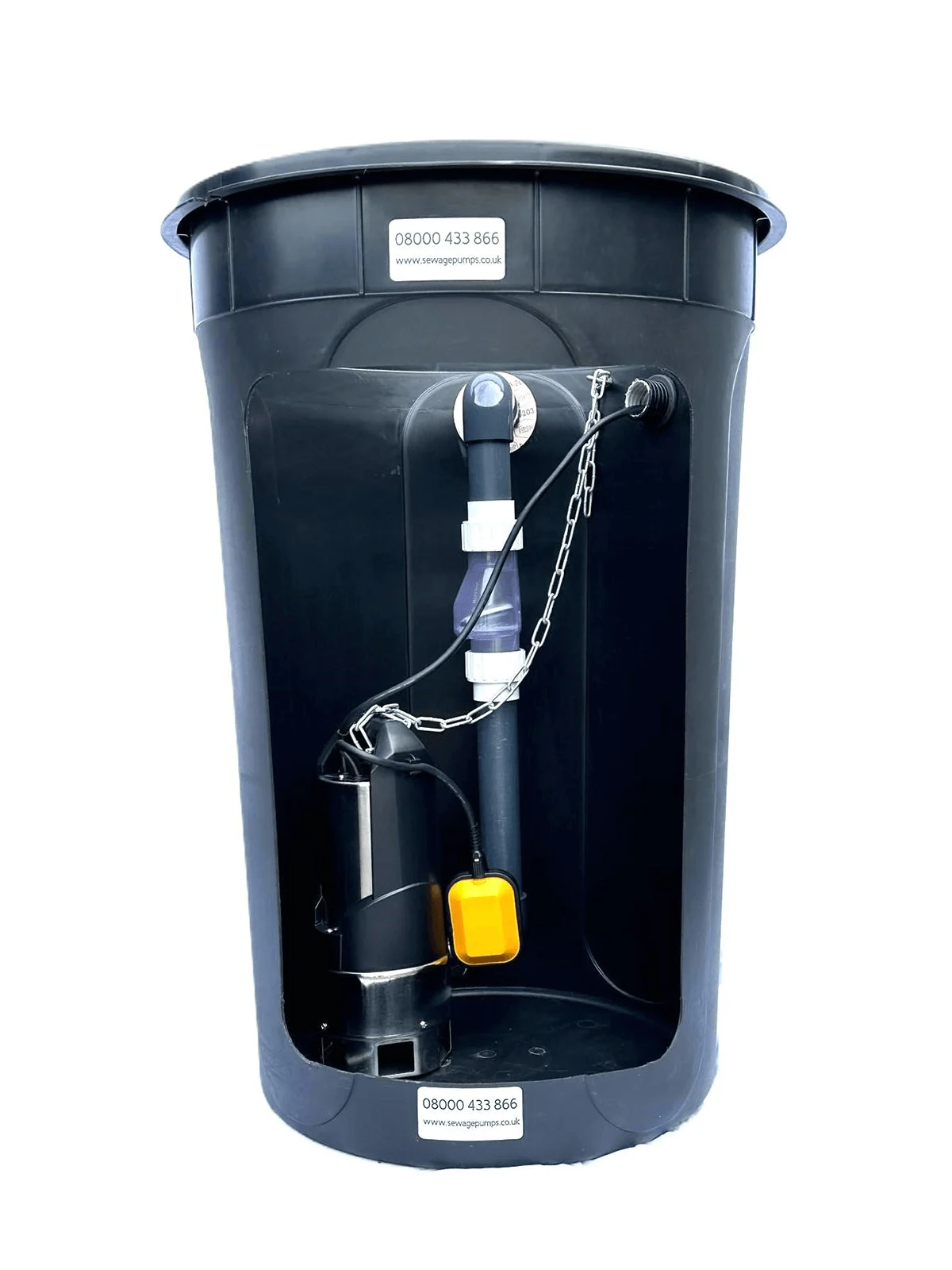
228 Litre Single Pump System (600mm x 0.8m)
£580.00 £696.00 incl. tax Add to basket -
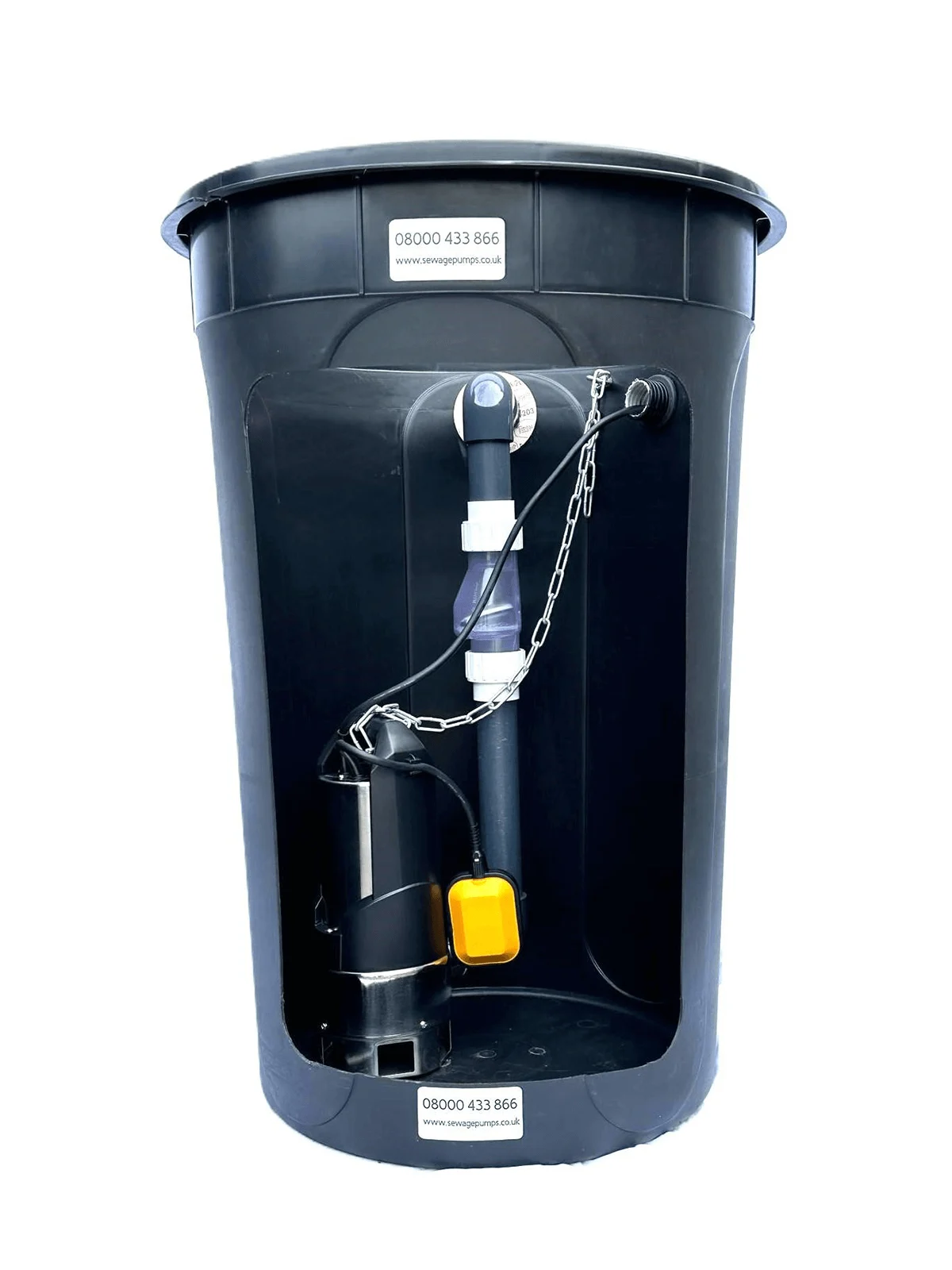
210 Litre Single Pump System (600mm x 1m)
£595.00 £714.00 incl. tax Add to basket -
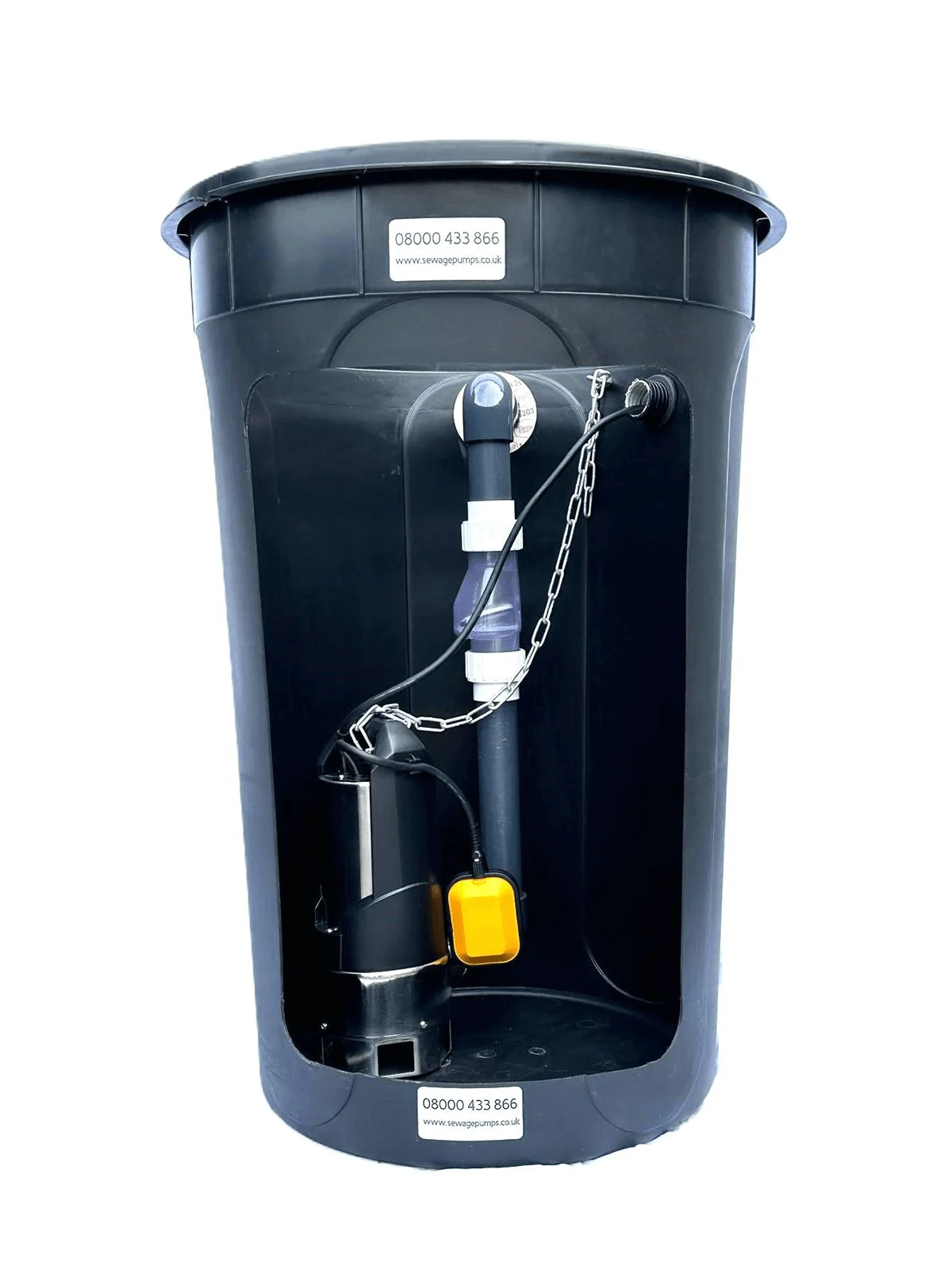
350 Litre Single Pump System (600mm x 1.3m)
£615.00 £738.00 incl. tax Add to basket -
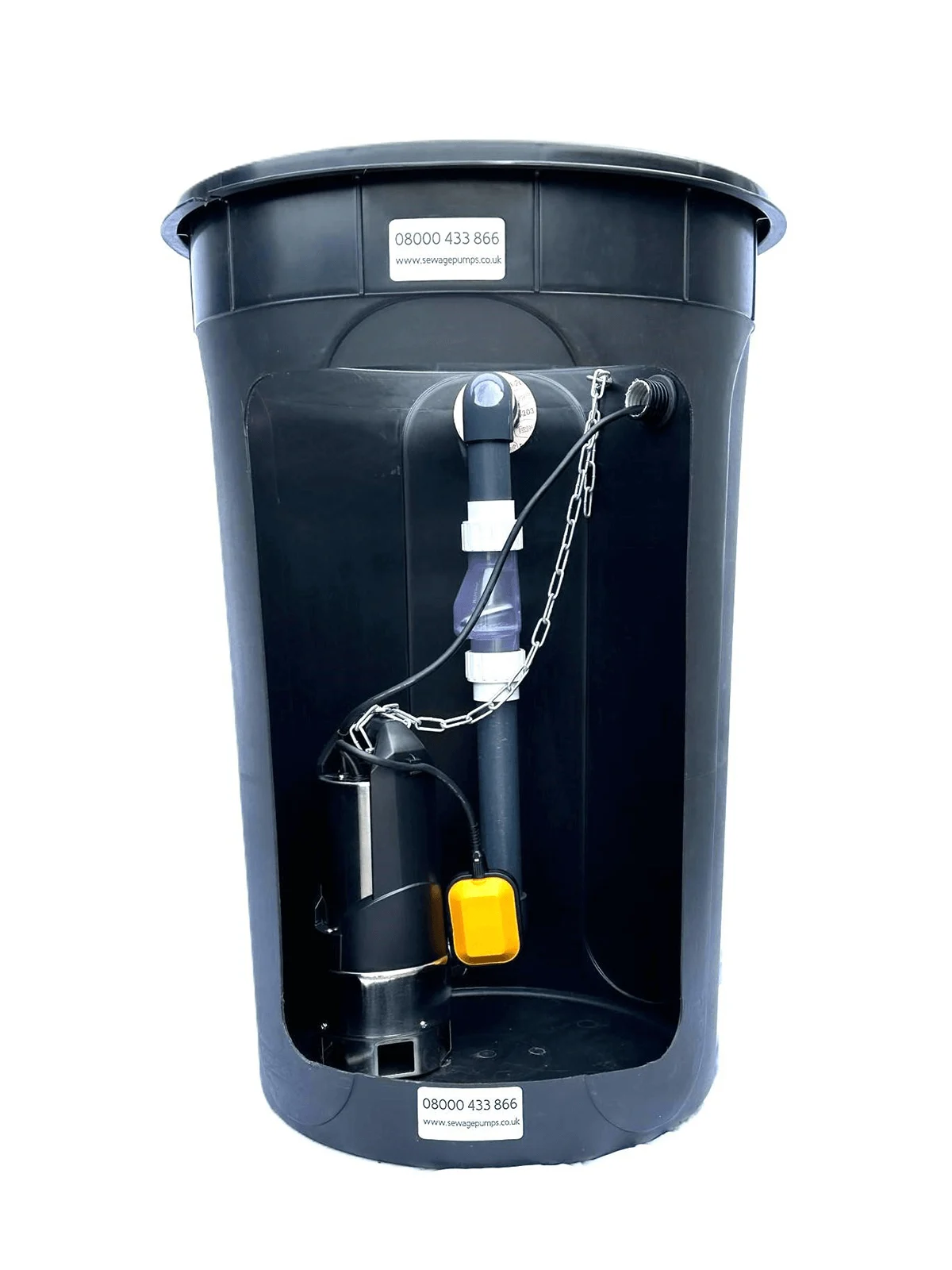
438 Litre Single Pump System (600mm x 1.5m)
£625.00 £750.00 incl. tax Add to basket -
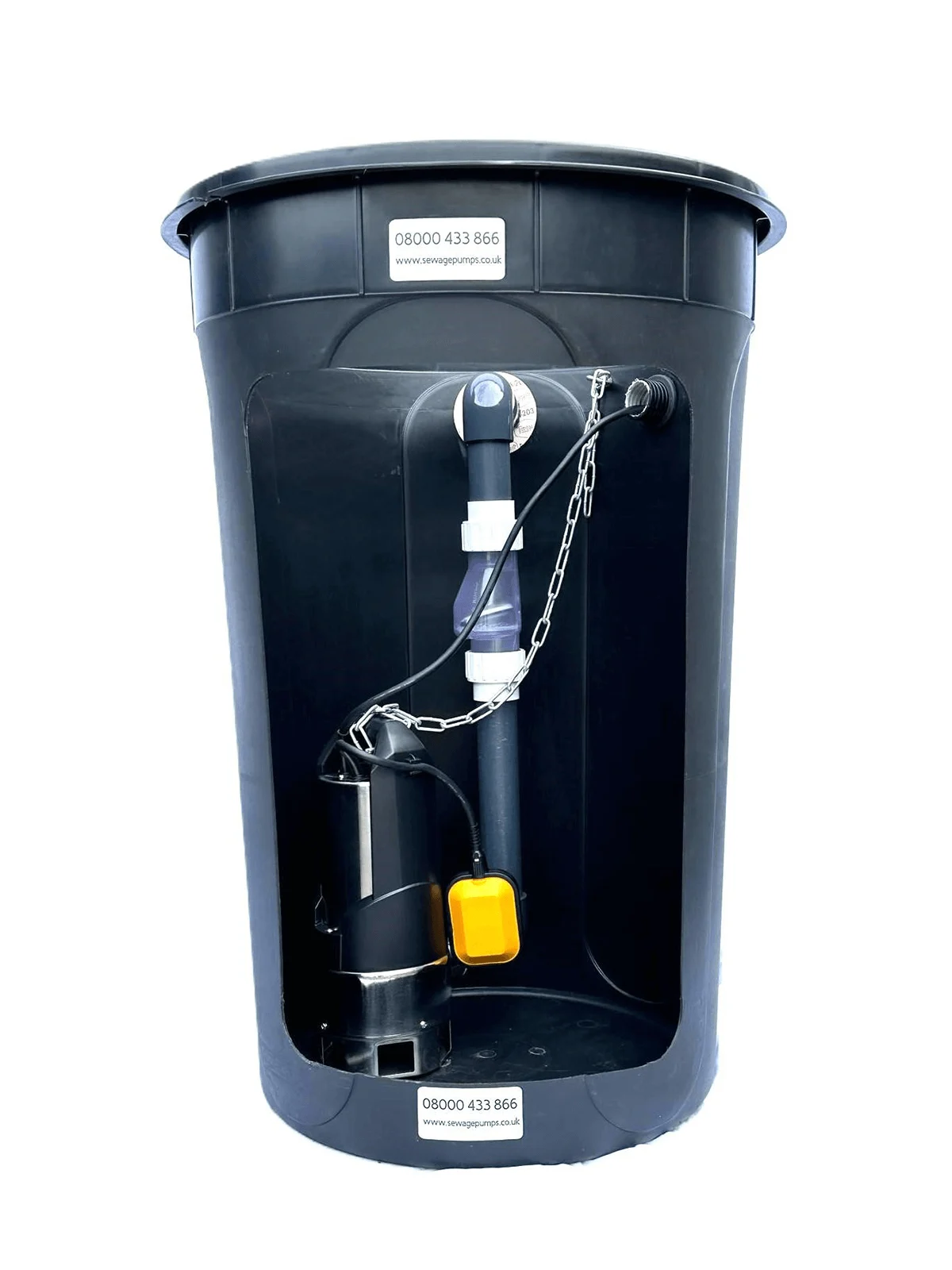
534 Litre Single Pump System (600mm x 2m)
£665.00 £798.00 incl. tax Add to basket -
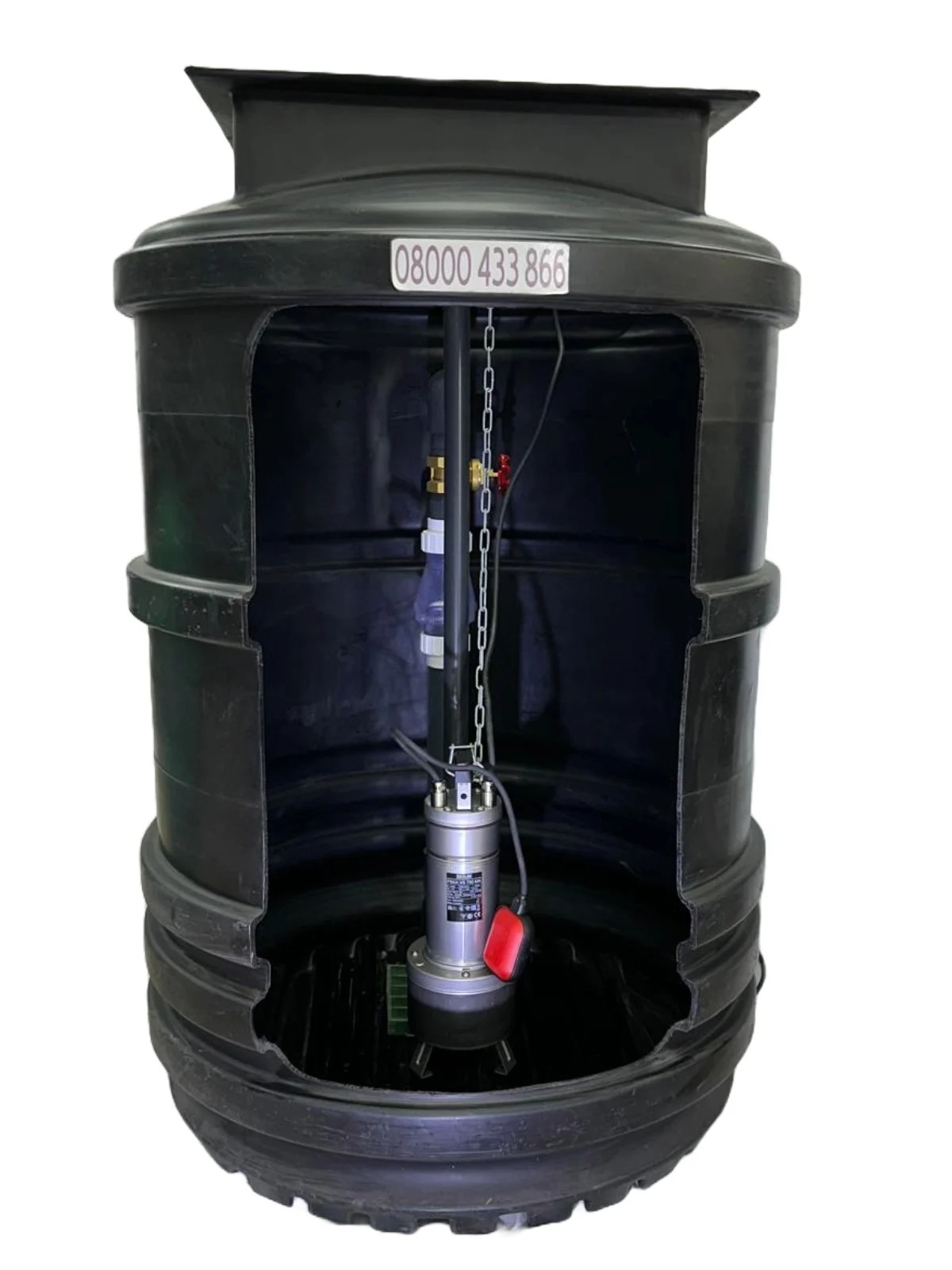
800 Litre Single Pump System (1000mm x 1m)
£1,045.00 £1,254.00 incl. tax Add to basket -
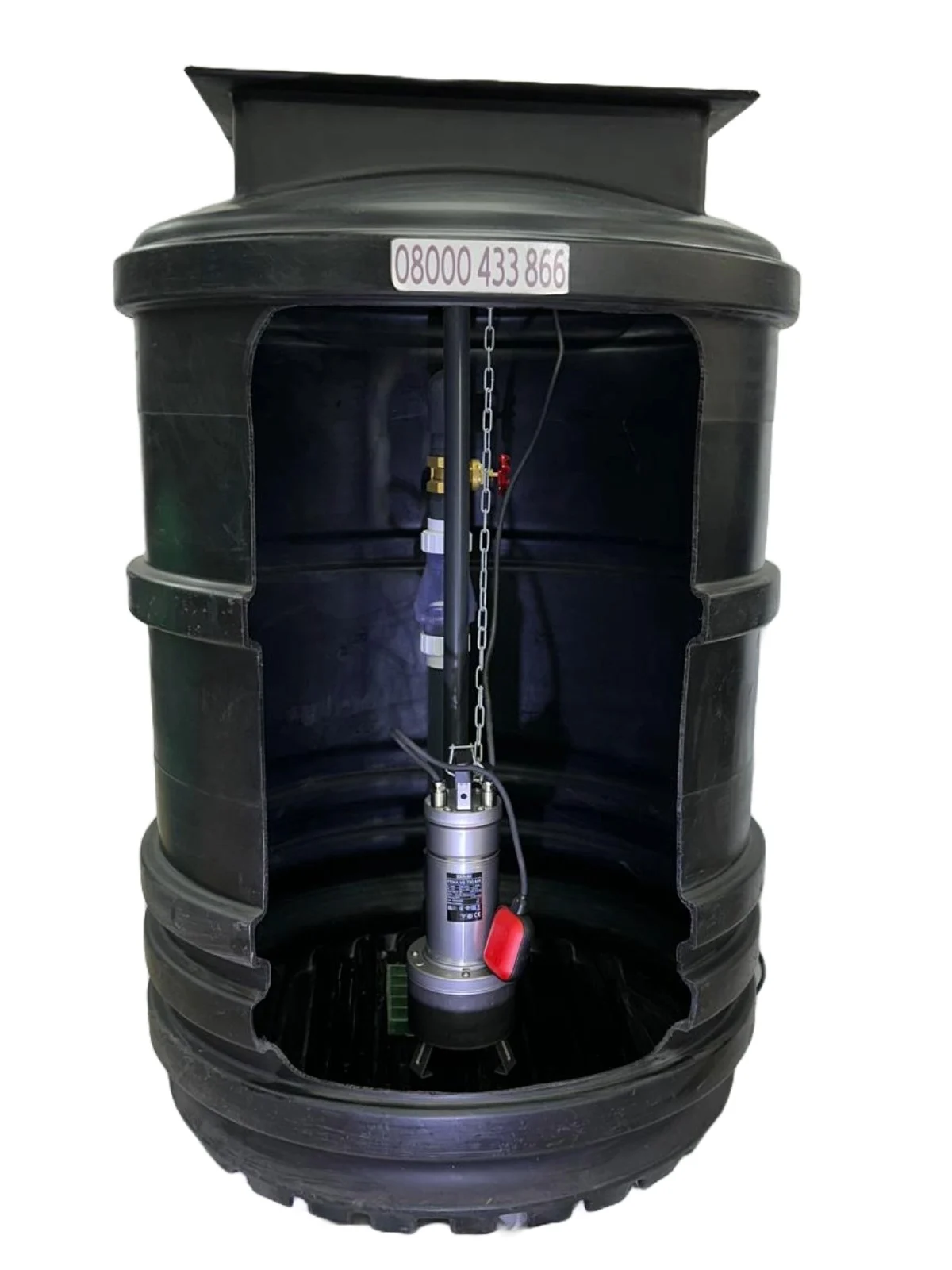
1100 Litre Single Pump System (1000mm x 1.5m)
£1,095.00 £1,314.00 incl. tax Add to basket -

1150 Litre Single Pump System (1200mm x 1m)
£1,250.00 £1,500.00 incl. tax Add to basket -
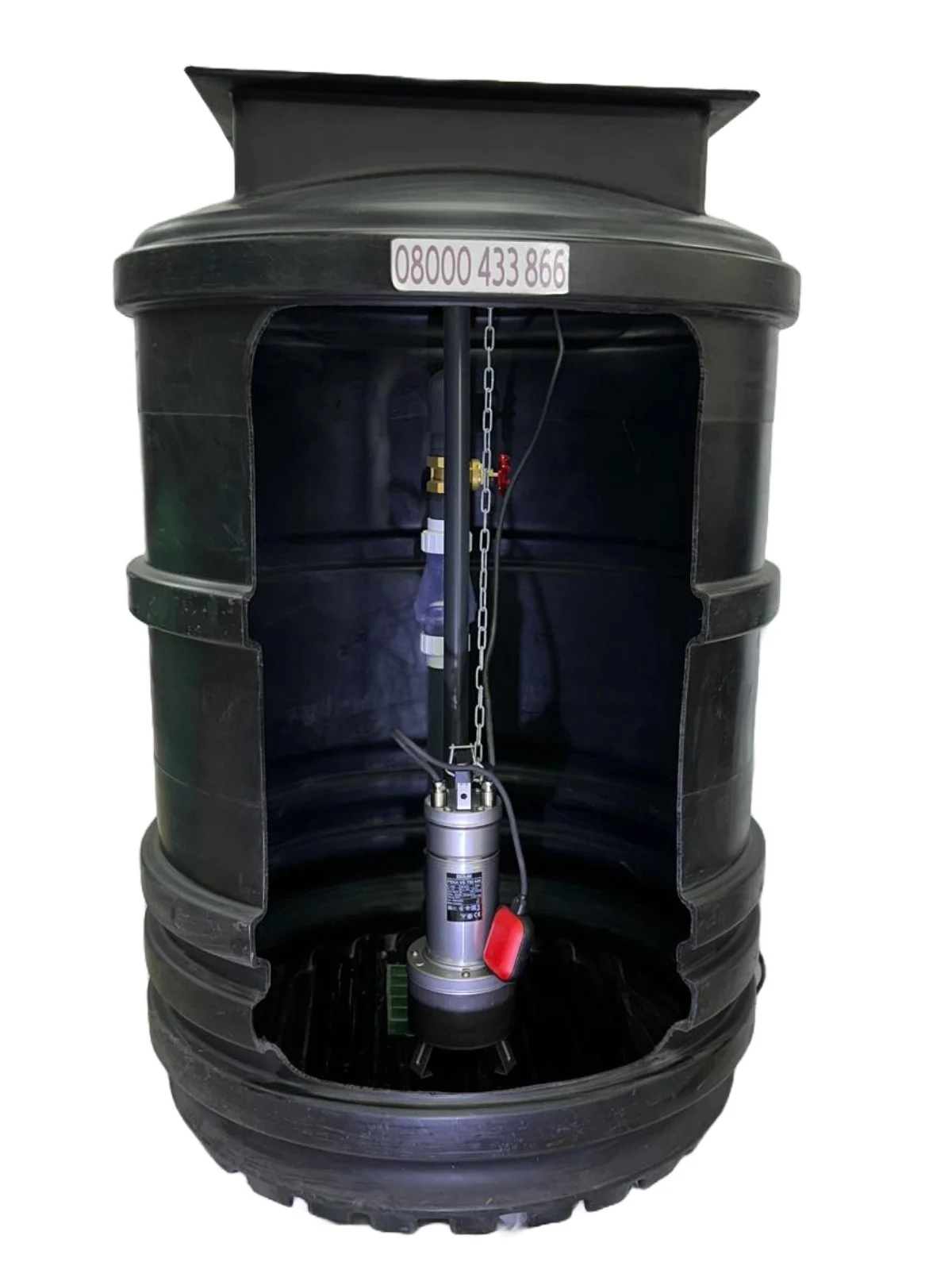
1400 Litre Single Pump System (1000mm x 1.85m)
£1,295.00 £1,554.00 incl. tax Add to basket -

1700 Litre Single Pump System (1000mm x 2.4m)
£1,650.00 £1,980.00 incl. tax Add to basket -
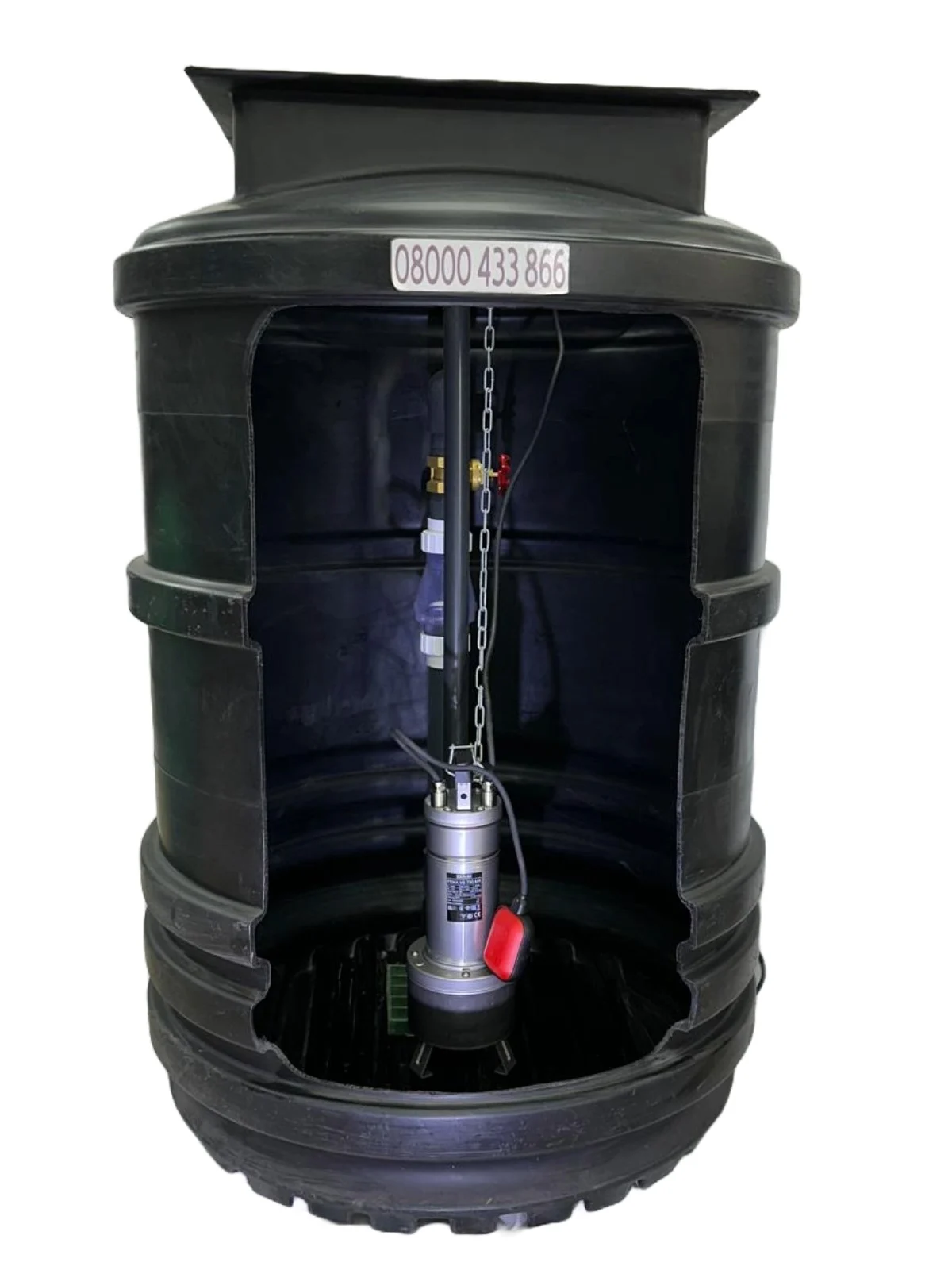
1450 Litre Single Pump System (1200mm x 1.5m)
£1,795.00 £2,154.00 incl. tax Add to basket -
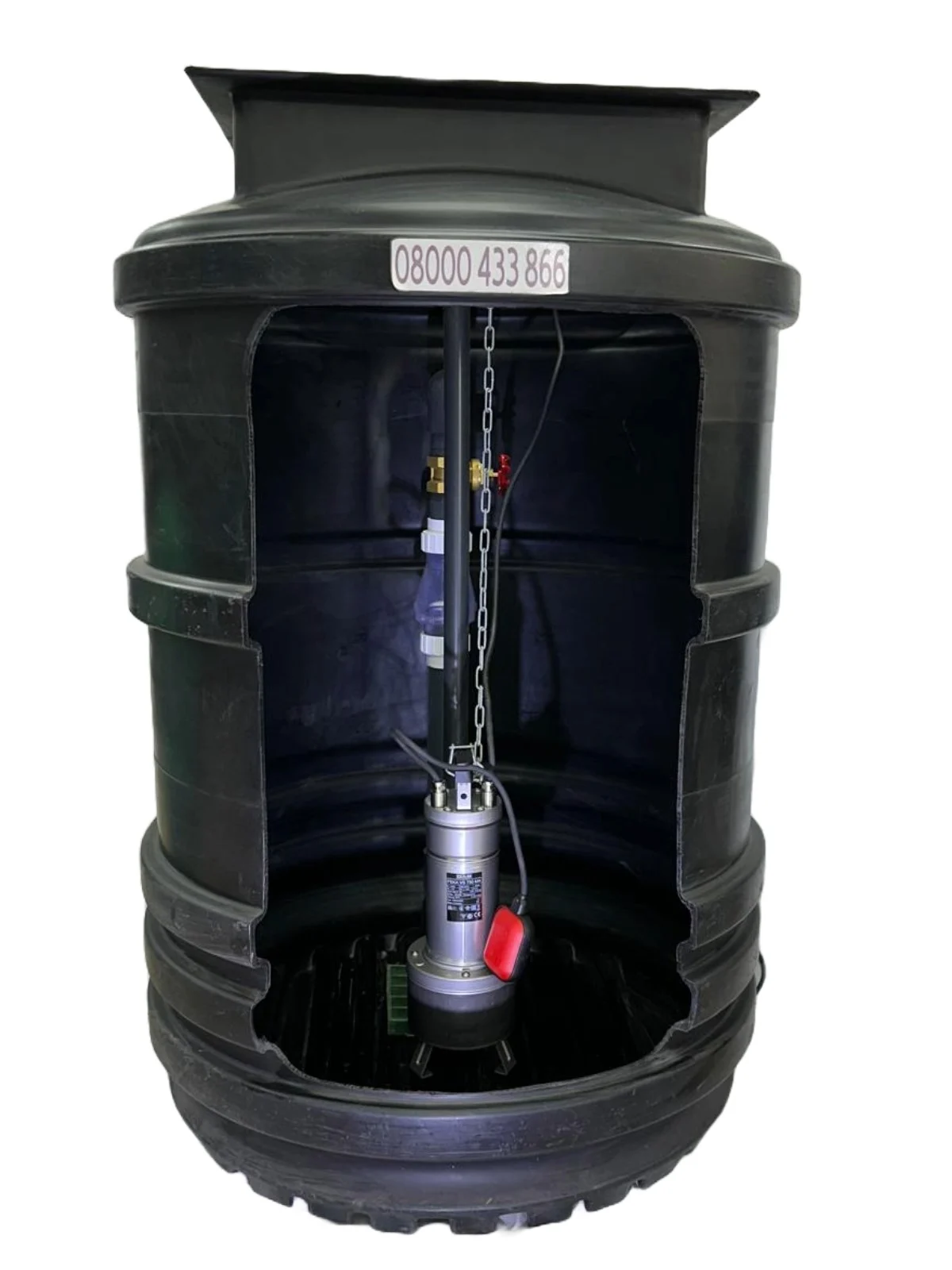
2150 Litre Single Pump System (1200mm x 2.1m)
£2,025.00 £2,430.00 incl. tax Add to basket -

800 Litre Dual Pump System (1000mm x 1m)
£2,045.00 £2,454.00 incl. tax Add to basket -

2000 Litre Single Pump System (1000mm x 2.8m)
£2,085.00 £2,502.00 incl. tax Add to basket -
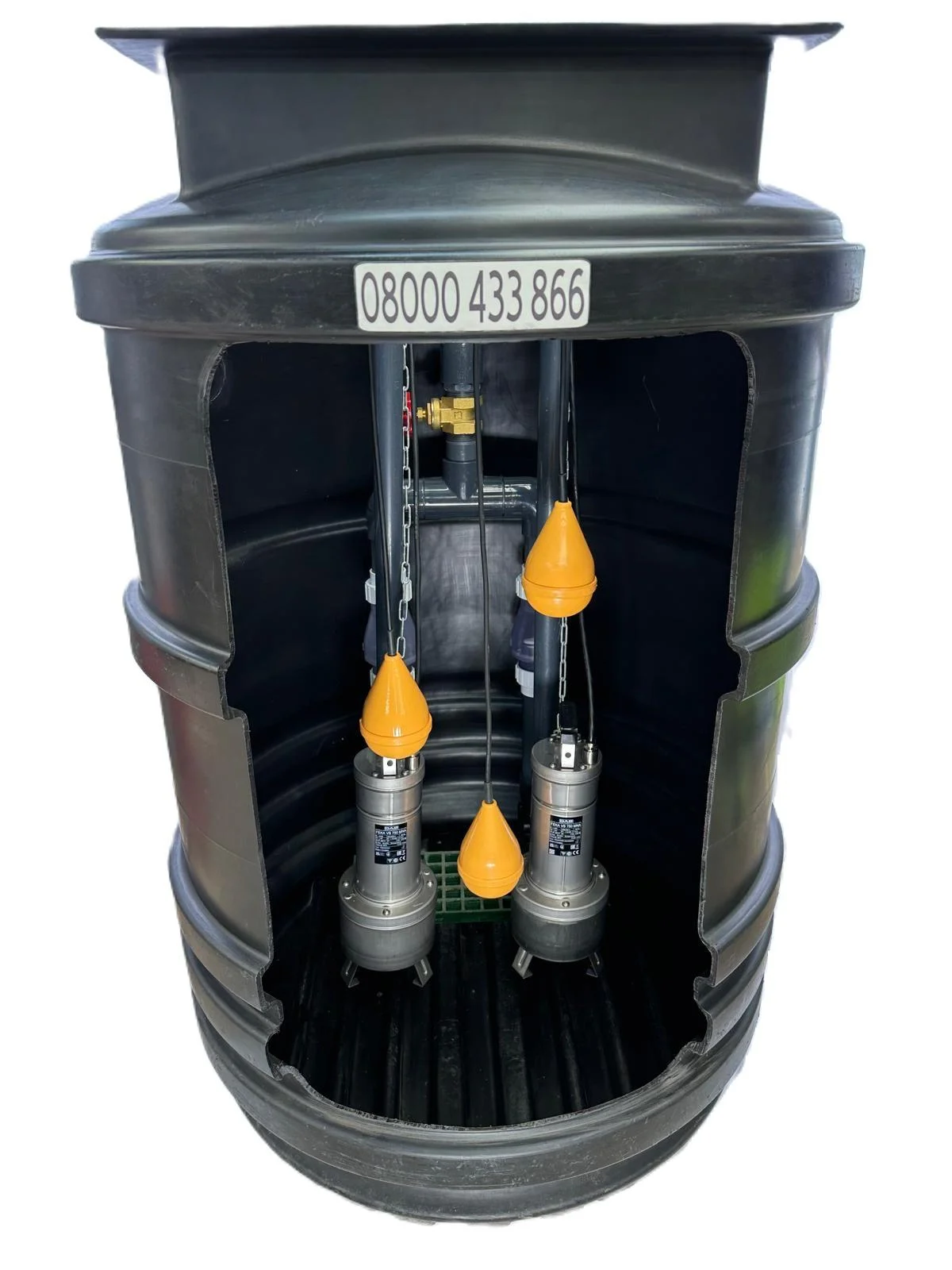
1100 Litre Dual Pump System (1000mm x 1.5m)
£2,095.00 £2,514.00 incl. tax Add to basket -
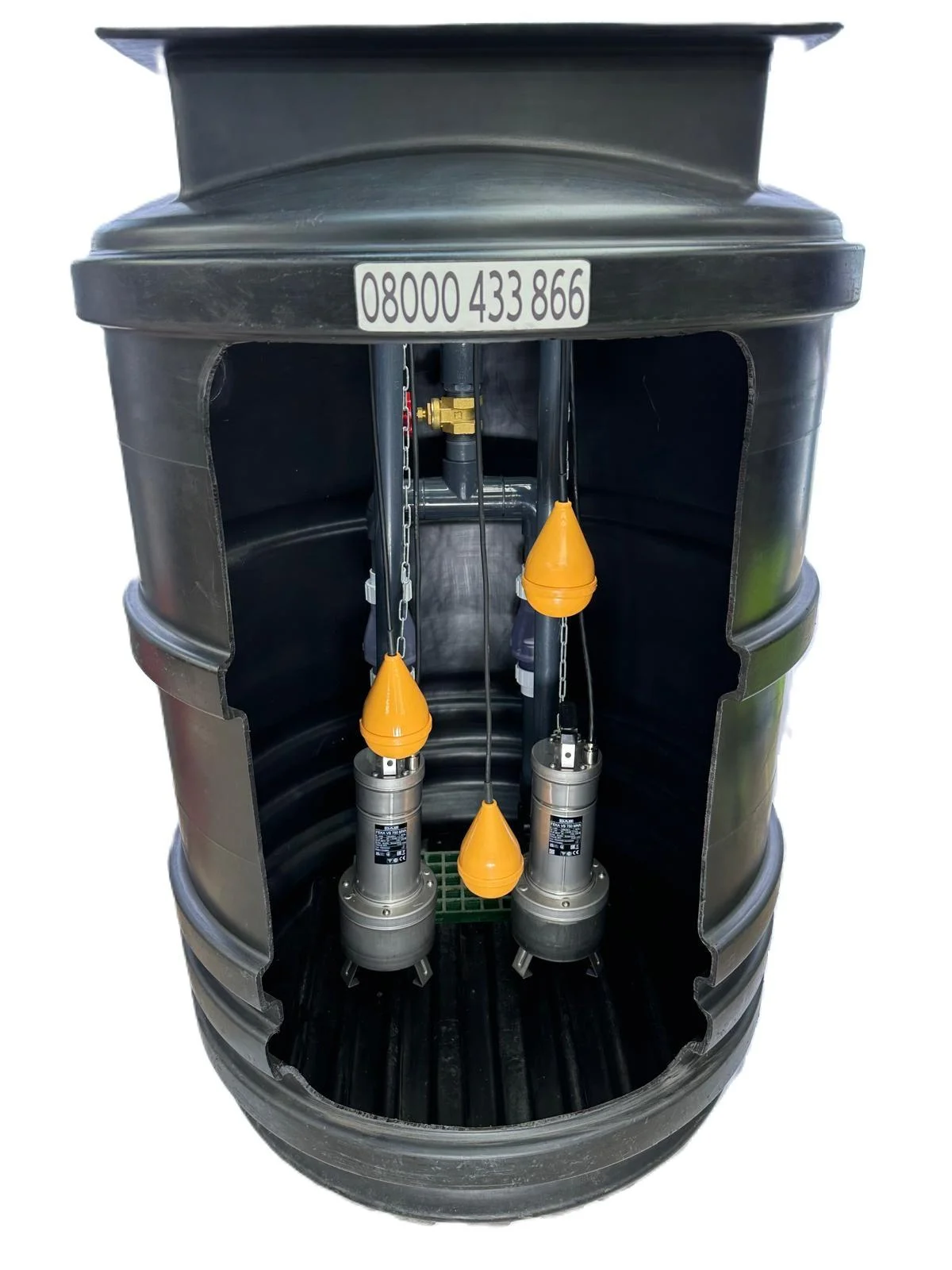
1400 Litre Dual Pump System (1000mm x 1.85m)
£2,345.00 £2,814.00 incl. tax Add to basket -
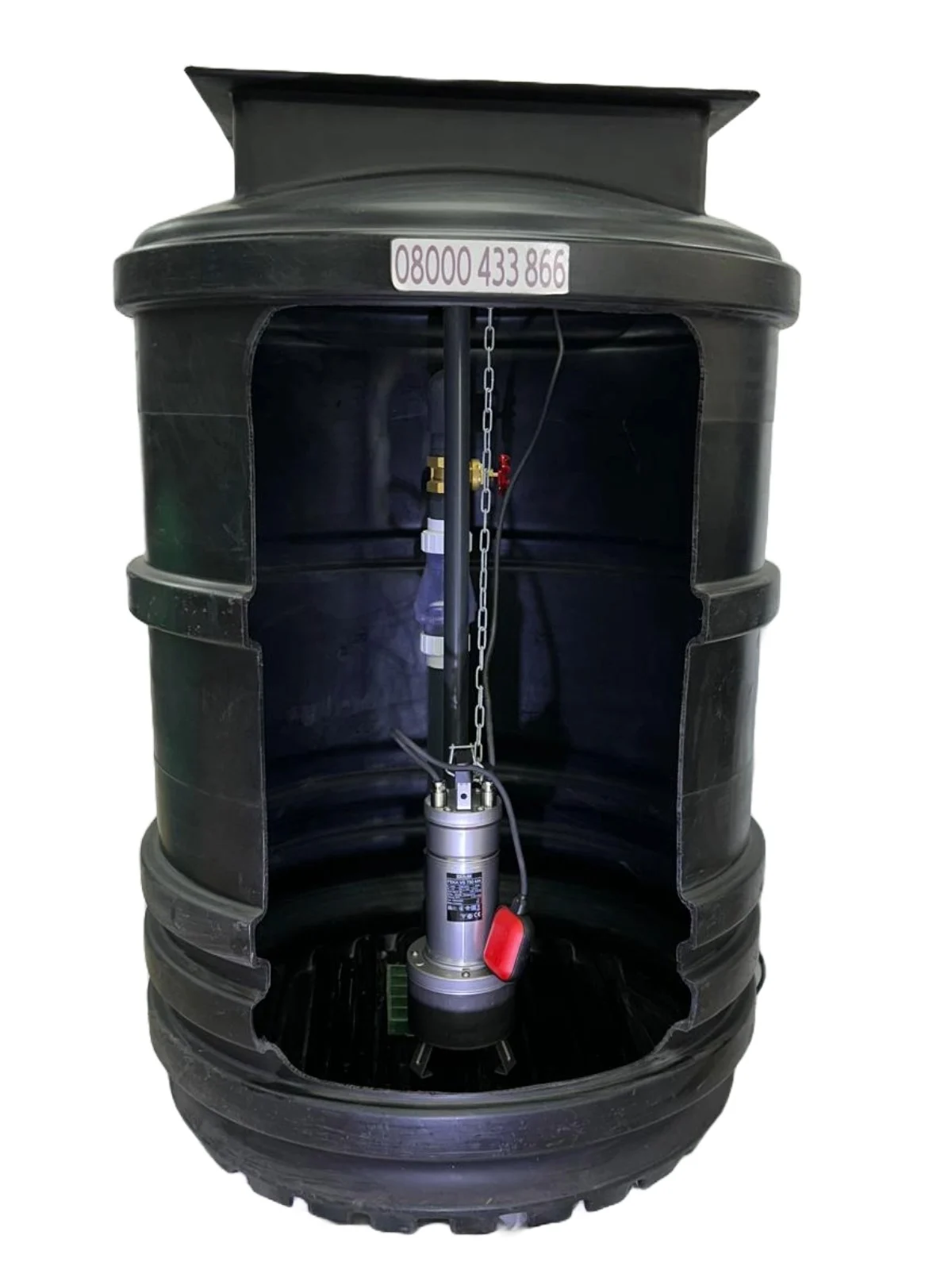
3400 Litre Single Pump System (1500mm x 1.9m)
£2,450.00 £2,940.00 incl. tax Add to basket -
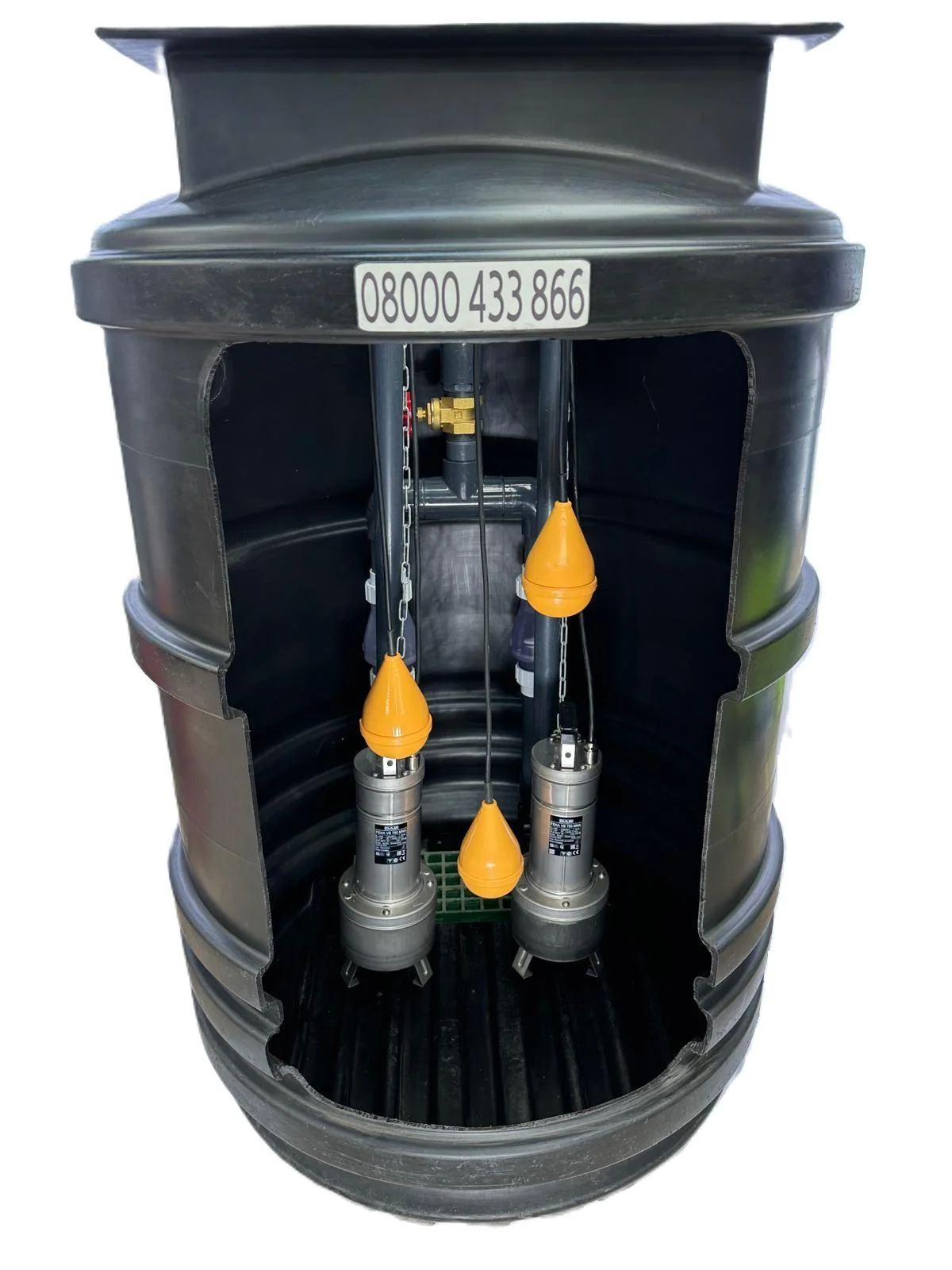
1450 Litre Dual Pump System (1200mm X 1.5m)
£2,750.00 £3,300.00 incl. tax Add to basket -
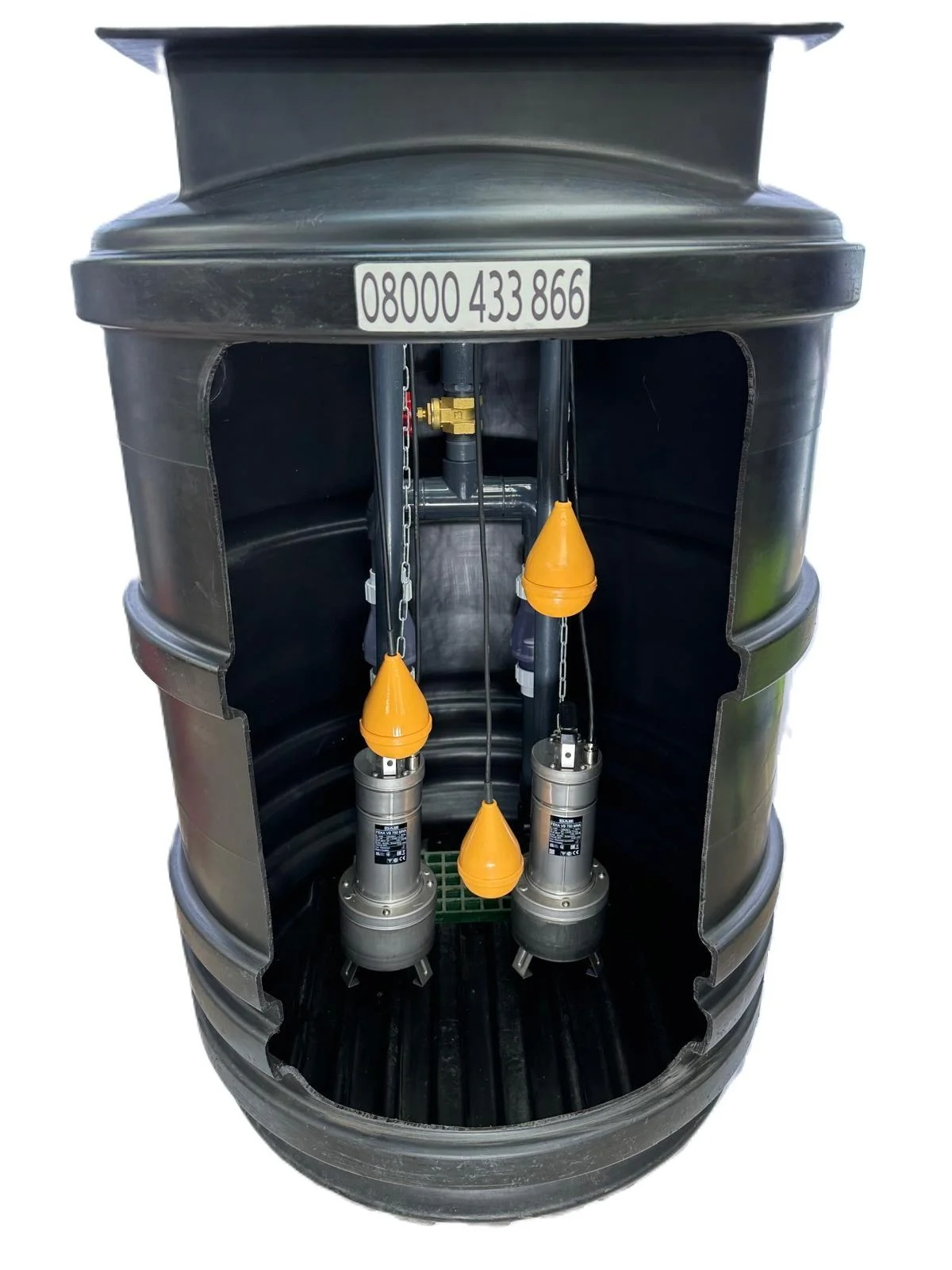
2150 Litre Dual Pump System (1200mm X 2.1m)
£3,000.00 £3,600.00 incl. tax Add to basket -
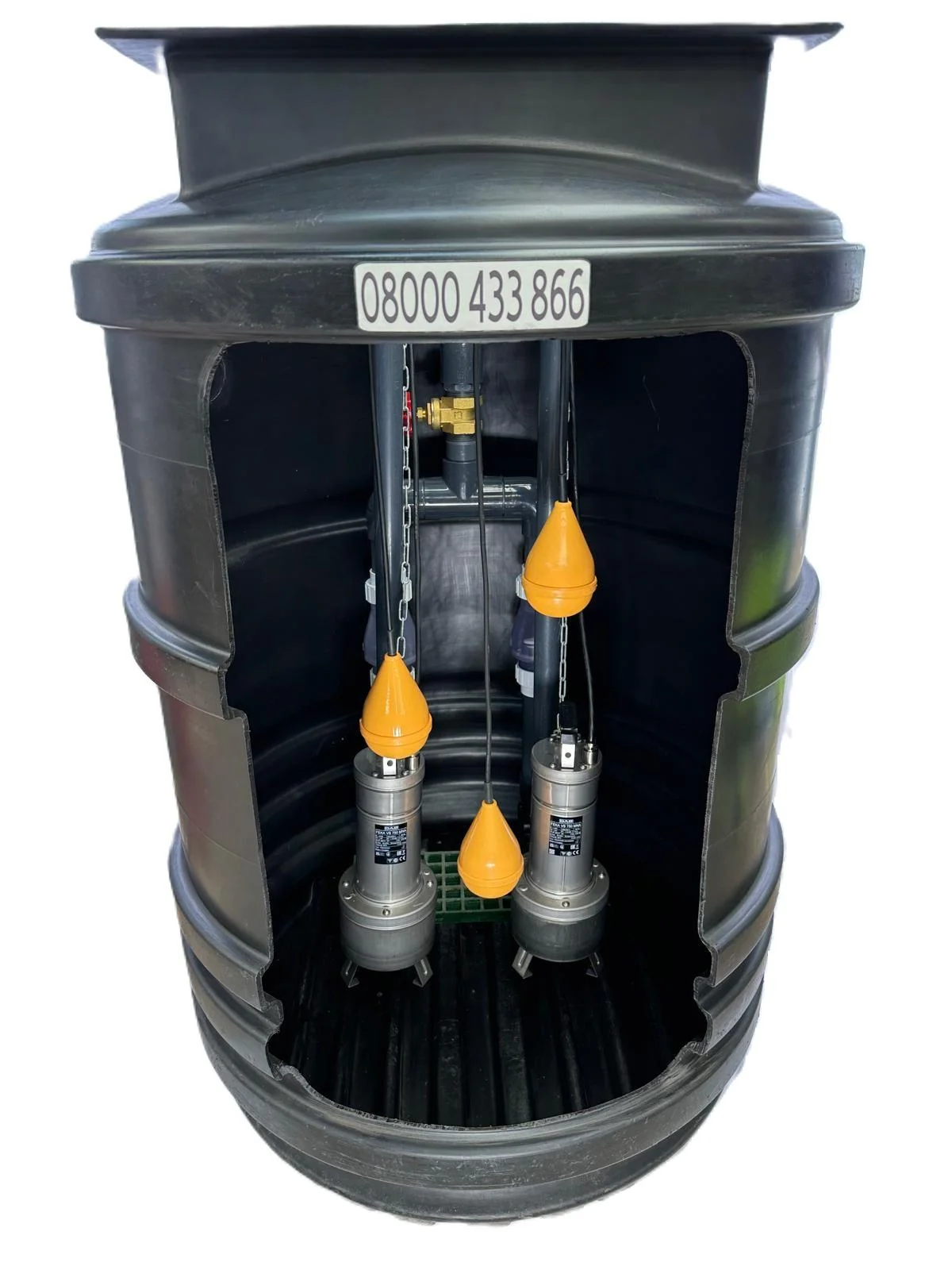
1700 Litre Dual Pump System (1000mm X 2.4m)
£3,200.00 £3,840.00 incl. tax Add to basket -
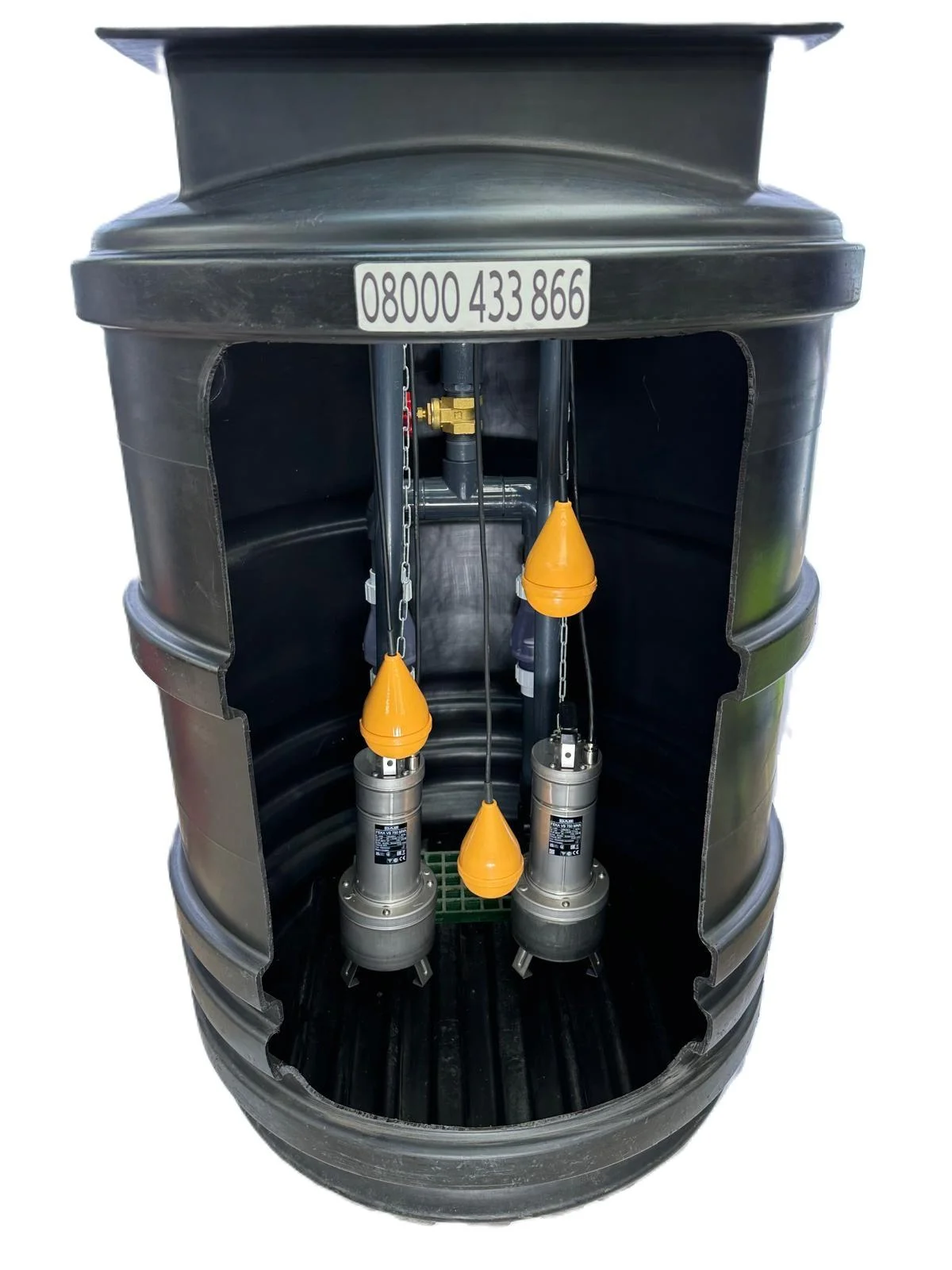
2000 Litre Dual Pump System (1000mm X 2.8m)
£3,750.00 £4,500.00 incl. tax Add to basket -
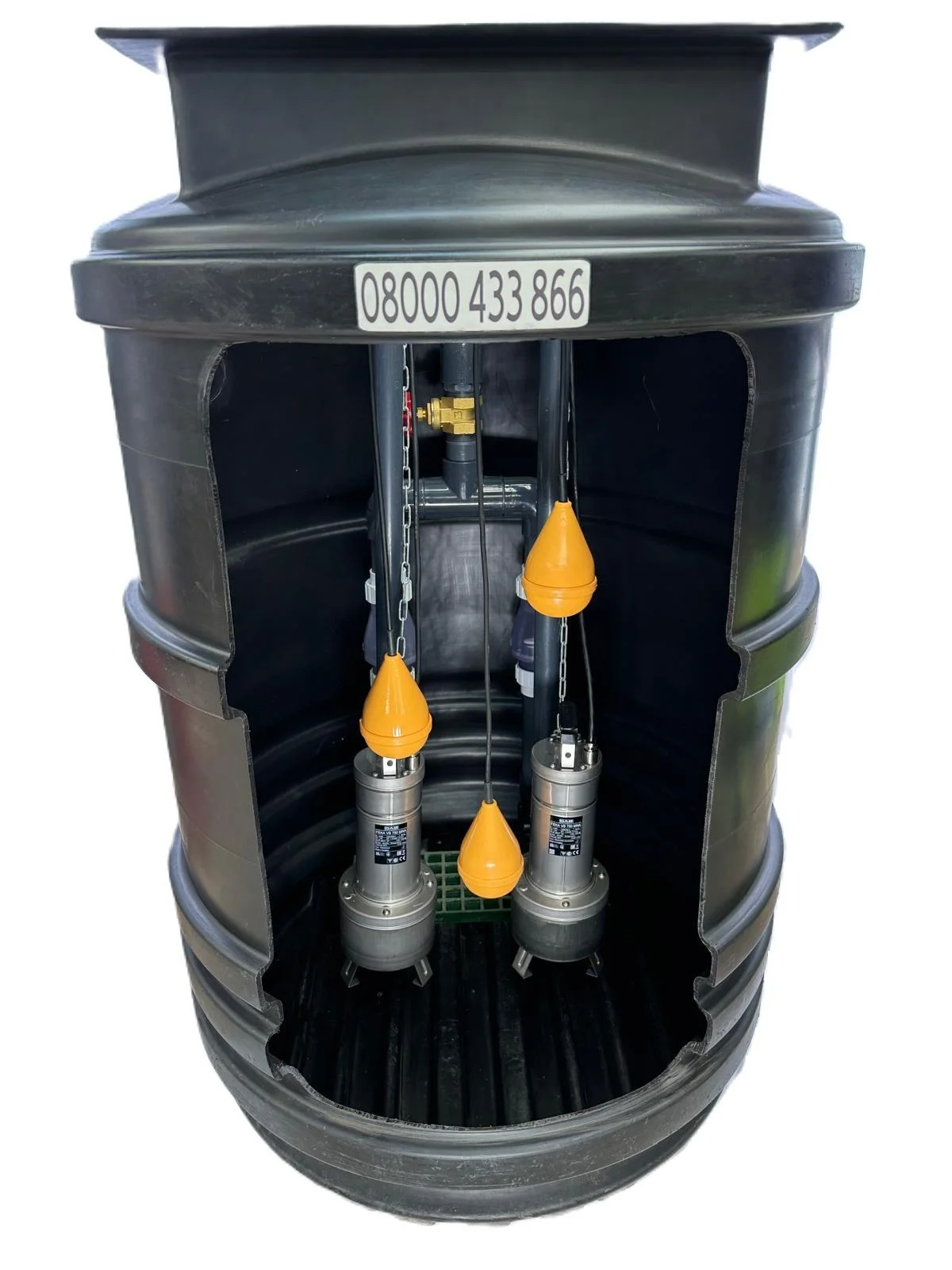
3400 Litre Dual Pump System (1500mm x 1.9m)
£3,850.00 £4,620.00 incl. tax Add to basket
Sewage Pump FAQS
What is a sewage pump?
A sewage pump (also called a wastewater pump) is a device that helps move sewage and wastewater—including solids and debris—from one place to another. It’s especially useful when gravity alone isn’t enough to do the job, like in basements or properties located below the main sewer line.
What Does It Do?
Sewage pumps help transport wastewater (including toilet waste, toilet paper, and other solids) from a home or building to the main sewer system or a septic tank when gravity can’t naturally pull it down.
How Does It Work?
These pumps sit in a tank or basin (also called a wet well) that collects sewage. Once the sewage reaches a certain level, the pump turns on and pushes the wastewater up and out to where it needs to go.
Types of Sewage Pumps
There are different kinds of sewage pumps, each with a specific job:
Grinder pumps – These have a built-in grinder that chops up solids to prevent clogs.
Non-grinder pumps – These can handle solids up to a certain size but don’t have a grinder.
Submersible pumps – These sit directly in the sewage and are designed for larger amounts of wastewater.
Sewage ejector pumps – These are commonly used in homes or small buildings to move sewage from a lower level (like a basement) up to the main sewer system.
Where Are They Used?
Sewage pumps are found in:
Homes with basements or properties below the main sewer line.
Commercial buildings.
Industrial facilities.
Sewage pumping stations, which move wastewater from homes and businesses to the main sewer system or treatment plant.
Why Are They Important?
Sewage pumps play a crucial role in keeping plumbing systems working smoothly. They help prevent backups, overflows, and sanitation issues, making sure wastewater gets where it needs to go safely and efficiently.
What type of sewage pump do I need for domestic properties?
For most homes, you’ll need either a solid-handling pump or a grinder pump, depending on whether you’re using a septic tank or pumping sewage straight into the sewer. Here’s a quick breakdown to help you choose the right one:
Types of Sewage Pumps
Solid-Handling Pumps (Sewage Ejector Pumps) – These pumps can move raw sewage, including solids, straight to a sewer or septic tank without breaking it down.
Grinder Pumps – These pumps chop up solids into a fine slurry before pumping, making it easier to move sewage, especially over longer distances.
Effluent Pumps – Used with septic tanks, these pumps handle mostly liquid waste since solids break down inside the tank.
Single vs. Twin Pump Systems
Twin pump systems are best for whole-house use because they provide a backup if one pump fails.
Single pump systems work well for smaller setups, like an extra bathroom or an outbuilding with a toilet.
What type of sewage pump do I need for commercial properties?
For most homes, you’ll need either a solid-handling pump or a grinder pump, depending on whether you’re using a septic tank or pumping sewage straight into the sewer. Here’s a quick breakdown to help you choose the right one:
Types of Sewage Pumps
Solid-Handling Pumps (Sewage Ejector Pumps) – These pumps can move raw sewage, including solids, straight to a sewer or septic tank without breaking it down.
Grinder Pumps – These pumps chop up solids into a fine slurry before pumping, making it easier to move sewage, especially over longer distances.
Effluent Pumps – Used with septic tanks, these pumps handle mostly liquid waste since solids break down inside the tank.
Single vs. Twin Pump Systems
Twin pump systems are best for whole-house use because they provide a backup if one pump fails.
Single pump systems work well for smaller setups, like an extra bathroom or an outbuilding with a toilet.
How does a sewage pump work?
A sewage pump (also called an ejector pump) helps move wastewater from a home or building to the main sewer line when gravity alone isn’t enough. It collects sewage in a tank and, once the level gets high enough, the pump kicks in to push the waste uphill until gravity takes over.
How It Works
Collecting Wastewater – Sewage flows into a tank or basin, known as a “wet well.”
Detecting the Level – When the sewage reaches a certain point, float switches or sensors activate the pump.
Pumping the Waste – A motor-powered pump (usually a centrifugal pump) spins an impeller to create pressure, pushing the wastewater out.
Moving It Uphill – The pump sends the waste up to a point where gravity can take over and carry it into the main sewer line.
Preventing Backflow – A special valve (non-return valve) stops wastewater from flowing back into the tank after pumping.
Grinding (Optional) – Some pumps have built-in grinders, like garbage disposals, that break down solids to prevent clogs.
Keeping It Running Smoothly – Regular maintenance, like cleaning and checking for leaks, keeps the pump working efficiently and helps prevent issues.
With the right setup and proper care, a sewage pump ensures wastewater flows smoothly without any mess or trouble!
What does a Sewage pump do?
A sewage pump (also called an ejector pump) helps move wastewater and solids from a home’s collection tank or basin to a sewer line or septic tank—especially when gravity alone can’t do the job.
Why Is It Needed?
Sewage pumps are useful when:
The main sewer line is higher than the sewage collection point.
There’s a lot of wastewater, and a gravity-based system can’t handle it efficiently.
How It Works
Wastewater flows into a tank or basin.
When it reaches a certain level, the pump automatically turns on.
The pump pushes the sewage uphill to the main sewer line.
From there, gravity takes over, moving it to the city sewer or septic tank.
Types of Sewage Pumps
Grinder Pumps – These have a built-in grinder to break down solids and prevent clogs.
Non-Grinder Pumps – These don’t grind solids and are best for situations where clogging isn’t a concern.
Where Are They Used?
Single-family homes typically use a one-tank system.
Duplexes or multi-family units may have two-tank systems for backup and reliability.
Why Are They Important?
Sewage pumps help prevent messy backups and keep wastewater flowing properly, ensuring a clean and sanitary environment.
Sewage Pumping Stations vs. Pump Stations
Sewage pumping stations store and manage wastewater with automatic controls that activate the pumps, moving sewage to the nearest sewer or manhole.
Pump stations lift and distribute wastewater when gravity can’t naturally move it away from a location.
With the right sewage pump system in place, wastewater management becomes smooth and worry-free!
How do I know if I need a sewage pump?
You might need a sewage pump if your home’s plumbing is below the main sewer line—this is common in basements or homes built on sloped land. Since gravity alone can’t move wastewater in these situations, a pump helps push it upward into the sewer system.
Do You Need a Sewage Pump?
Your Home’s Location Matters – If your house sits on a slope or has plumbing below the main sewer line, a sewage pump is likely needed to move wastewater uphill.
Basement Bathrooms – If you have a bathroom in the basement, you almost certainly need a sewage pump since it’s lower than the main sewer line.
Signs You Might Have a Problem
Watch out for these warning signs that a sewage pump might be necessary (or that your current one isn’t working properly):
Slow Drains – If your sinks, tubs, or toilets drain slowly or clog often, your drainage system may need a boost.
Sewage Odor – A persistent bad smell could mean waste is backing up instead of flowing properly.
Sewage Backup – Water or waste coming back up into sinks, tubs, or toilets is a clear sign of a problem.
Pooling Water – Water collecting in your yard or near the house might indicate a septic or sewage issue.
Strange Noises – If your sewage pump is making odd sounds, it could be struggling to work properly.
What is the difference between a drainage pump and a sewage pump?
The main difference between a drainage pump and a sewage pump is what they handle. Drainage pumps move clean or slightly dirty water, while sewage pumps are built to handle wastewater with solids and debris.
Drainage Pumps
Purpose – These pumps are used to remove excess water from places like basements, crawl spaces, and around foundations to prevent flooding and water damage.
Fluid Type – They handle clean or slightly contaminated water, like rainwater, groundwater, or water that’s seeped into a basement.
Design – Drainage pumps are typically smaller, lighter, and less powerful than sewage pumps, with simpler designs that don’t handle solids.
Examples – Sump pumps are commonly used in basements to pump out extra water.
Sewage Pumps
Purpose – Sewage pumps move wastewater, including human waste and other solids, from places where gravity can’t push it to a sewer or septic system.
Fluid Type – These pumps handle wastewater with solids, like toilet waste, greywater, and other household wastewater.
Design – Sewage pumps have stronger motors and impellers to handle solids. Some even have grinders to break down solids before pumping.
Examples – Sewage ejector pumps are used in homes with basements or areas below the sewer line.
Each pump does a specific job to keep your home safe and dry!
How do you prevent blockages in a sewage pump?
To keep your sewage pump running smoothly and prevent blockages, follow these simple steps:
1. Choose the Right Impeller Type
Pick an impeller like a screw channel or chopper pump, which are less likely to clog compared to traditional types.
2. Educate Users
Let everyone know what they should and shouldn’t flush! Remind them to avoid flushing things like wipes, sanitary products, and too much grease.
3. Remove Floating Solids
Check the pump station regularly and remove any floating solids that could get sucked into the pump and cause problems.
4. Rotate Duty and Standby Pumps
Make sure to rotate the pumps so they’re all used evenly. This prevents solids from building up in one pump and keeps everything running smoothly.
5. Set Up a Regular Service Schedule
Have a regular service plan where you clean and check the pumps to stop solids from building up and causing blockages.
6. Watch for Unusual Noises or Flow
Listen for strange sounds or notice if the water flow slows down—these could be signs of a blockage.
7. Consider Automated Cleaning
Some pumps have variable speed drives that can clean automatically. This helps prevent blockages in wastewater systems.
8. Handle Fat Blockages
If fat buildup is an issue, think about installing a fat trap, using a vacuum tanker for regular cleaning, adding an aerator, or installing a mixer.
By following these steps, you can help prevent blockages and keep your sewage pump working well!
What happens when sewage pump fails?
If a sewage pump stops working, wastewater can back up, causing big problems like overflowing toilets, bad smells, and potential health risks. Here’s what can happen if your sewage pump fails:
What Happens When a Sewage Pump Fails?
Sewage Backups – The biggest issue is that wastewater can’t be pumped out, so it backs up into toilets, sinks, and other drains.
Flooding – If the backup is bad enough, it could flood your basement or other areas with sewage.
Bad Odors – Standing sewage smells terrible and can make the area unlivable.
Health Hazards – Contact with raw sewage can spread harmful bacteria and viruses, creating serious health risks.
Environmental Harm – If a pump station fails, raw sewage could end up in the environment, harming wildlife, including fish.
Property Damage – Sewage backups can damage your home’s floors, furniture, and electrical systems.
Plumbing Shutdown – A failed pump can shut down your whole plumbing system, leaving you without running water or the ability to flush toilets.
Other Signs of a Problem
Look out for these issues that might signal the pump is malfunctioning:
Unusual Noises – Strange squeals, bangs, or grinding noises could mean something’s wrong.
Gurgling Sounds – If you hear gurgling in the pipes, it might be a sign that the pump isn’t working right.
Pump Runs Nonstop – If the pump keeps running without stopping, it could be a sign of a malfunction.
Motor Issues – The motor might fail due to electrical problems, overheating, or wear and tear.
Overheating – If the pump overheats, it can get damaged and stop working properly.
Float Switch Problems – A faulty float switch can stop the pump from turning on or off when needed.
Blocked Impeller – A blocked impeller can cause the pump to overheat or fail to work properly.
Damaged Pipes – Broken or corroded pipes can also cause problems with your pump.
If you notice any of these signs or a pump failure, it’s important to get it checked out quickly to avoid bigger issues like damage or health risks!
How many years does a sewage pump last?
A sewage pump usually lasts around 7 to 10 years, but this can change depending on a few things like the pump’s quality, how often it’s used, and how well it’s maintained.
How Long Does a Sewage Pump Last?
Average Lifespan – Most sewage pumps last about 7 to 10 years.
What Affects the Lifespan?
Pump Quality – High-quality pumps with features like corrosion resistance and efficient motors tend to last longer.
Usage Frequency – The more the pump is used, the quicker it might wear out.
Maintenance – Regular cleaning and inspections can help the pump last much longer.
By taking good care of your pump, you can get the most out of it!
How far can a sewage pump pump sewage?
Sewage pumps, like sewage ejector pumps, help move raw sewage from your home to a septic tank or sewer system. They’re built to handle sewage over short distances (up to 750 feet) and can move large amounts of waste (up to 200 gallons per minute).
Sewage Ejector Pumps
These pumps are designed to move raw sewage from your home to a septic tank or gravity sewer system.
Distance: Sewage ejector pumps are great for shorter distances, usually under 750 feet.
Volume: They can handle large amounts of sewage, with some models moving up to 200 gallons per minute.
Grinder Pumps
Grinder pumps also move raw sewage, but they’re built to handle longer distances—sometimes over thousands of feet. They grind up sewage to make it easier to pump over greater distances.
Head Pressure
Sewage pumps use an impeller to create head pressure, which helps push the sewage upwards. The height that the pump can move the sewage is called total dynamic head or simply “head.”
Choosing the Right Pump
When picking a pump, consider:
The amount of sewage you need to pump
Where it needs to go
How far it needs to travel
Professional Help
It’s a good idea to talk to a professional to find out which sewage pump is best for your home. So just give us a call and we will guide you.
Do I have a sump pump or sewage pump?
To figure out if you have a sump pump or a sewage pump, here’s a simple way to tell:
Sump Pump: This is used to remove water from your basement or crawl space, usually to prevent flooding. It pumps out clean water, like rainwater or groundwater, to keep your home dry.
Sewage Pump: This handles wastewater and sewage, including things like toilet waste or kitchen water. It’s used when gravity can’t carry the waste to a sewer or septic system, like in basements or lower areas of a home.
So, if it’s moving clean water to prevent flooding, you likely have a sump pump. If it’s moving wastewater, then you probably have a sewage pump
What type of pump is used for sewage?
When it comes to sewage pumping, the most common types are submersible pumps and centrifugal pumps, with centrifugal pumps being the most popular because they are easy to use and can handle a lot of sewage at once.
Centrifugal Pumps
These pumps work by using a rotating impeller to push sewage through the pump and out the discharge pipe. They’re known for their high flow rates and simple design.
“Free passage” pumps are a type of centrifugal pump that lets solids pass through without getting clogged, which is really important in sewage systems.
Submersible Pumps
These pumps are designed to be fully submerged in the liquid they’re pumping. This makes them great for sump pits or tanks where you need to pump wastewater.
They’re often used in packaged pump stations when gravity alone can’t do the job.
Other Types of Pumps
Grinder Pumps: These break down sewage to be moved over longer distances, great for areas with low flow rates.
Chopper Pumps: These are built for tough conditions and can handle a lot of fibrous materials.
Why Are These Pumps Used?
Sewage pumps help move wastewater and soft solids. Their special design makes sure solids can pass through without causing clogs, which is key to keeping the system running smoothly.
Do sewage pumps need maintenance?
Yes, sewage pumps need regular maintenance to keep working well and avoid breakdowns. This includes cleaning, checking parts, and replacing anything that’s worn out. Here’s why and how to take care of your sewage pump:
Why Maintenance is Important
Sewage pumps deal with wastewater, which can cause clogs, rust, and wear over time. Regular maintenance helps catch any problems early, saving you from expensive repairs and environmental issues.
How to Maintain Your Sewage Pump
Clean Regularly: Remove debris and buildup from the pump and nearby area to stop blockages.
Check Parts: Look at the impellers, seals, and bearings for wear. Replace anything that’s damaged.
Monitor Performance: Keep an eye on things like flow rate, pressure, and energy use to spot problems early.
Annual Servicing: It’s a good idea to have your pump inspected and cleaned once a year.
Get Professional Help: For complex systems, it’s smart to hire a pro for regular checks and maintenance.
Signs Your Pump May Have a Problem
Weird sounds like squeals, bangs, or grinding.
Slow drains.
Bad smells.
Sewage backups or overflows.
Dirty water.
Pump won’t start or is struggling to start.
The pump runs constantly.
Benefits of Regular Maintenance
Keeps things flowing smoothly.
Helps avoid mechanical breakdowns.
Prevents sewage backups and plumbing issues.
Saves you money in the long run.
Extends the life of your pump.
